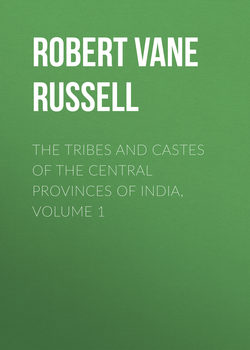Читать книгу The Tribes and Castes of the Central Provinces of India, Volume 1 - Robert Vane Russell - Страница 29
Part I.
Introductory Essay on Caste
Introductory Essay on Caste
26. Castes from whom a Brāhman cannot take water; the village menials
ОглавлениеThe third main division consists of those castes from whom a Brāhman cannot take water, though they are not regarded as impure and are permitted to enter Hindu temples. The typical castes of this group appear to be the village artisans and menials and the village priests. The annexed list shows the principal of these.
Village menials.
• Lohār—Blacksmith.
• Barhai—Carpenter.
• Kumhār—Potter.
• Nai—Barber.
• Dhimar—Waterman.
• Kahār—Palanquin-bearer.
• Bāri—Leaf-plate maker.
• Bargāh—Household servant.
• Dhobi—Washerman.
• Darzi—Tailor.
• Basor or Dhulia—Village musician.
• Bhāt and Mirāsi—Bard and genealogist.
• Halba—House-servant and farm-servant.
Castes of village watchmen.
• Khangār.
• Chadār.
• Chauhān.
• Dahāit.
• Panka.
Village priests and mendicants.
• Joshi—Astrologer.
• Gārpagāri—Hail-averter.
• Gondhali—Musician.
Others.
• Māli—Gardener and maker of garlands.
• Barai—Betel-vine grower and seller.
Other village traders and artisans.
• Kalār—Liquor-vendor.
• Teli—Oil-presser.
Banjāra—Carrier.
• Bahna—Cotton-cleaner.
• Chhīpa—Calico-printer and dyer.
• Chitrakathi—Painter and picture-maker.
• Kachera—Glass bangle-maker.
• Kadera—Fireworks-maker.
• Nat—Acrobat.
The essential fact which formerly governed the status of this group of castes appears to be that they performed various services for the cultivators according to their different vocations, and were supported by contributions of grain made to them by the cultivators, and by presents given to them at seed-time and harvest. They were the clients of the cultivators and the latter were their patrons and supporters, and hence ranked above them. This condition of things survives only in the case of a few castes, but prior to the introduction of a metal currency must apparently have been the method of remuneration of all the village industries. The Lohār or blacksmith makes and mends the iron implements of agriculture, such as the ploughshare, axe, sickle and goad. For this he is paid in Saugor a yearly contribution of 20 lbs. of grain per plough of land held by each cultivator, together with a handful of grain at sowing-time and a sheaf at harvest from both the autumn and spring crops. In Wardha he gets 50 lbs. of grain per plough of four bullocks or 40 acres. For new implements he must either be paid separately or at least supplied with the iron and charcoal. In Districts where the Barhai or carpenter is a village servant he is paid the same as the Lohār and has practically an equal status. The village barber receives in Saugor 20 lbs. of grain annually from each adult male in the family, or 22½ lbs. per plough of land besides the seasonal presents. In return for this he shaves each cultivator over the head and face about once a fortnight. The Dhobi or washerman gets half the annual contribution of the blacksmith and carpenter, with the same presents, and in return for this he washes the clothes of the family two or three times a month. When he brings the clothes home he also receives a meal or a wheaten cake, and well-to-do families give him their old clothes as a present. The Dhīmar or waterman brings water to the house morning and evening, and fills the earthen water-pots placed on a wooden stand or earthen platform outside it. When the cultivators have marriages he performs the same duties for the whole wedding party, and receives a present of money and clothes according to the means of the family, and his food every day while the wedding is in progress. He supplies water for drinking to the reapers, receiving three sheaves a day as payment, and takes sweet potatoes and boiled plums to the field and sells them. The Kumhār or potter is not now paid regularly by dues from the cultivators like other village menials, as the ordinary system of sale has been found to be more convenient in his case. But he sometimes takes for use the soiled grass from the stalls of the cattle and gives pots free to the cultivator in exchange. On Akti day, at the beginning of the agricultural year, the village Kumhār in Saugor presents five pots with covers on them to each cultivator and is given 2½ lbs. of grain. He presents the bride with seven new pots at a wedding, and these are filled with water and used in the ceremony, being considered to represent the seven seas. At a funeral he must supply thirteen vessels which are known as ghāts, and must replace the household earthen vessels, which are rendered impure on the occurrence of a death in the house, and are all broken and thrown away. In the Punjab and Marātha country the Kumhār was formerly an ordinary village menial.
